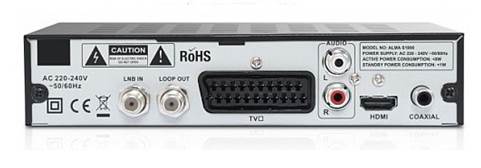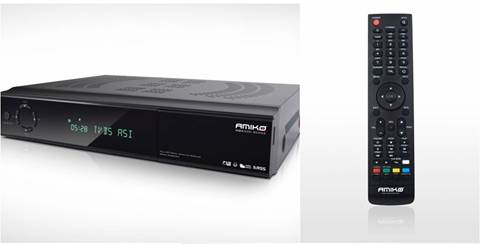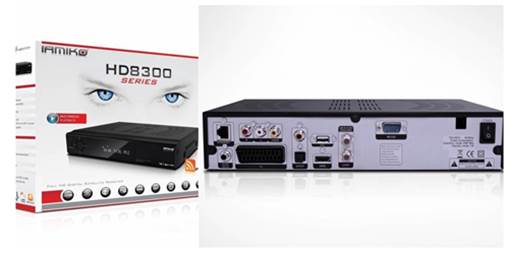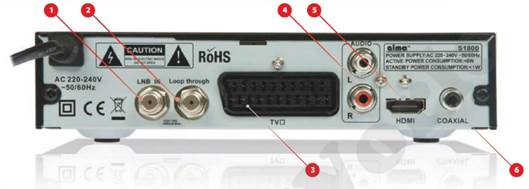If you thought you couldn’t get a
high definition satellite receiver with PVR recording for just $60… well, think
again
The opposition
Rockdable REL50/12HD
Similar spec and similar limited PVR
facilities, with better (although confusing) navigation and faster searches but
nearly twice the price
Ferguson Ariva 102mini
Even smaller (to be hidden away), but with
SAM, better navigation and PVR, but poor connectivity and nearly twice as
expensive
A few months ago, $52.5 for an SD satellite
receiver (the BigSAT Golden 1CR) seemed almost too good to be true. Now, the
S1800 comes along for just $7.5 more and it’s a high definition machine with
PVR support.
While the S1800 is not quite the fount of features
that some (more expensive) machines are, it is certainly a fully-functioning
receiver with a size that will appeal to caravan owners and other spatially
challenged viewers (although it is mains powered so you’ll need an inverter to
use it with a 12V supply).
Build and connectivity
Unlike many diminutive receivers that
abandon the ‘normal’ set-top box arrangement for a compact format, this unit
follows the standard form. Looking at the photograph, you wouldn’t guess it is
just 18cm across. The size of the front USB socket (for PVR storage) gives the
game away a little, but the conventional front panel, complete with central
numeric display make the S1800 a miniature version of a normal box; almost a
dolls house receiver. It’s a wonder how the mains power supply was crammed in
there along with the rest of a complete HD digital receiver.

The
size of the front USB socket (for PVR storage) gives the game away a little,
but the conventional front panel
The remote control is not so miniaturized,
but it’s no large, classy handset either. The buttons are rather close together
and the layout is a little odd in places. However, this is a budget machine,
after all.
The back panel holds few surprises, except
that it suffers from far less corner-cutting than might be expected at this
price. The one LNB input has a loop through output too. The S1800 can support
all the DiSEqC formats 1.0 and 1.1 for up to 16-way LNB switches and 1.2 and
USALS for motorized mounts.
The main output is via HDMI (with full
1080p output), but there’s also a Scart socket for SD, and audio is available
from both coaxial digital and stereo analogue connections. There’s no USB on
the rear so PVR storage must plug in at the front – a bit disfiguring for this
cute receiver.
Setup
The S1800 is installed in the normal way,
albeit with a ‘fewer screens’ approach. The satellites to receive are selected
from a list (or added, if new) and the LNB parameters set up for each one.
Then you search the satellites individually
or sequentially. Searching can be for free-to-air channels only, or for just
TV, or just radio. You can perform a normal database can be edited as
transmissions change) or a blind search. However, you can’t search a single
transponder. The S1800 is not fast at searching. In particular, blind searches
take what is for today an interminably long time.
Basic use
Features to make using the S1800 quicker or
easier have been pared to the bone. The onscreen channel list shows the
channels in the order stored, with a euro symbol for encrypted ones. Although
there is a channel search to find channels starting with an entered string,
there is no way to reorder or filter the list. So if you want to see FTA
channels, you have to scroll through the lot.
The EPG is also simple to the extreme; just
a listing of the programmers on the current channel – all seven days of it, if
broadcast, with the synopsis of the selected show. One sophistication is that
you can book a timer event for an individual show, and access the timer with
single button pushes, but otherwise, it’s very basic.
‘The back panel holds few surprises,
except that it suffers from far less corner-cutting than might be expected at
this price’
PVR and multimedia
While there’s no room in the S1800 for a
built-in HDD, you can connect any USB storage to enable the PVR facilities but
these are not too extensive. The S1800 can only record one channel at a time,
although a second channel at a time, and although a second channel on the same
transponder can be viewed, you cannot record this as well.

While
there’s no room in the S1800 for a built-in HDD, you can connect any USB storage
to enable the PVR facilities but these are not too extensive.
You can pause a live broadcast but not in
the ‘normal’ way. Pressing the Time shift button simply records the current
channel and, although you can then pause and rewind this, it’s no different in
effect to pressing Record. Change channels (on the same transponder) and the
recording goes on in the background and when you stop, you’ll find it there in
the recordings list.
The only difference between Time shift and
recording is that with the Time shift mode you can start to watch a recording
before it’s finished (by rewinding back to the start).
A nice touch, missing from many PVRs is
that you can resume playback where you last left off, but otherwise, the S1800
is bereft of playback features. There is no visual indication of how far
through the file you are (the Info button shows figures) and the only way of
moving the playback point is the fast forward and reverse controls (up to x32).
However, the Alma can also playback MP3
music files and photos from the connected storage, as well as video files in a
decent range of formats.
Performance
The S1800 may be lacking in physical
stature, but for reception performance it stands tall. Sound from both digital
and analogue outputs is up to scratch, the images from HD channels are crisp
and lively, and SD channels rendered well too.
SD output from the Scart socket is a
welcome inclusion and doesn’t disappoint. Playback is largely indistinguishable
from live reception and the S1800 performs well as a media player for video,
music, and photos, too.
Verdict
While the S1800 may well be bought by some
on the basis of its small size, most will probably be attracted by the price. While
navigation, EPG, and PVR functions are limited and searches are slow, this is a
truly cheap box. It’s hard to believe that $60 can get you a high definition
receiver with PVR facilities, and that may be enticing.

It’s
hard to believe that $60 can get you a high definition receiver with PVR
facilities, and that may be enticing.
Ratings
Plus
·
Extremely cheap
·
Very small (and rather cute)
·
Good image and sound performance
Minus
·
Limited PVR facilities
·
Poor navigation and EPG
·
Slow search speeds
·
Build: 7/10
·
Setup: 8/10
·
Searching: 6/10
·
Navigation: 7/10
·
Performance: 8/10
·
Features: 7/10
·
Value: 10/10
·
Overall: 7.6/10
Connectivity

1.
LNB input
2.
LNB loop through output
3.
TV Scart
4.
Stereo analogue audio
5.
HDMI
6.
Coaxial digital audio output
Test and measurement
Power usage
This small receiver has a matching power
consumption, using a modest 12W even when going full out
·
Idling: N/A
·
In use: 12W
·
Standby: <1W
Search: 28.20E
Database scans are very slow due to
unnecessarily large database but reducing that speeds them up
·
FTA scan: 8m58s
·
Full scan: 9m27s
·
Blind search: 11m40s
Search: 19.20E
Long time for all searches, but the blind
search in particular is slow compared to some boxes
·
FTA scan: 6m08s
·
Full scan: 6m26s
·
Blind search: 13m14s
Search 130E
Unusually, 130E searches are faster
than 19.20E, but they are still slow for a modern receiver
·
FTA: 6m00s
·
Full scan: 6m20s
·
Blind search: 11m21s
·
Video formats
·
MPEG-2: Yes
·
AVI: Yes
·
VivX: Yes
·
Xvid: No
·
MKV: Yes
·
WMV: No
·
VOB: No
|
Specifications
·
No LNB inputs: 1
·
LNB Loop through: Yes
·
DiSEqC: 1.0, 1.1, 1.2, USALS
·
No. channels: 5000
·
Selectable FEC: No
·
Symbol rate range: 2000-60000
·
Blind search: Yes
·
Linux: No
·
CAM: none
·
Common Interface: None
·
Teletext: DVB decoded
·
EPG support: DVB now/next, 7-day
·
Timer: 30-events, 50-years
·
Hard drive: via USB
·
UHF modulator tuning: n/a
·
Software upgrade: OTA
·
Data ports: USB
·
AV outputs
·
SD out: Scart
·
HD out: HDMI
·
Audio out: Stereo analogue audio, coaxial
digital audio
|